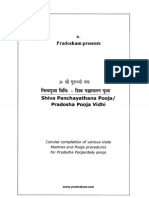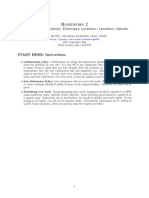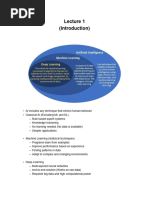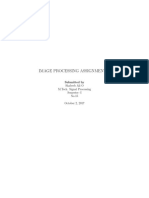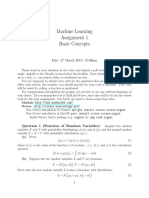Detection and Pattern Recognition: Matlab: 1 Supervised Classification
Uploaded by
ace.kris8117Detection and Pattern Recognition: Matlab: 1 Supervised Classification
Uploaded by
ace.kris8117UNIVERSITT STUTTGART
LEHRSTUHL FR SYSTEMTHEORIE UND SIGNALVERARBEITUNG
Prof. Dr.-Ing. B. Yang
Collection of Problems of the Exercises in
Detection and Pattern Recognition: Matlab
Additional Problems are marked with
Version: July 5, 2012
Contents
1 Supervised Classification
1.1 Mean Classifier . . . . .
1.2 Mahalanobis distance . .
1.3 XOR Feature Transform
1.4 Feature Normalization .
1.5 Hard Margin SVM . . .
.
.
.
.
.
.
.
.
.
.
.
.
.
.
.
.
.
.
.
.
.
.
.
.
.
.
.
.
.
.
.
.
.
.
.
.
.
.
.
.
.
.
.
.
.
.
.
.
.
.
.
.
.
.
.
.
.
.
.
.
.
.
.
.
.
.
.
.
.
.
.
.
.
.
.
.
.
.
.
.
.
.
.
.
.
.
.
.
.
.
.
.
.
.
.
.
.
.
.
.
.
.
.
.
.
.
.
.
.
.
.
.
.
.
.
.
.
.
.
.
.
.
.
.
.
.
.
.
.
.
.
.
.
.
.
.
.
.
.
.
.
.
.
.
.
.
.
.
.
.
.
.
.
.
.
1
1
1
2
2
3
Collection of Problems of the Exercises in Detection and Pattern Recognition: Matlab
1 Supervised Classification
1.1 Mean Classifier
Use the protoype provided to implement a mean classifier using the euqlidian distance.
(a) Compute the mean i for every class i , i = 1, . . . , C by using the training examples.
(b) Compute the distance from each sample to each class mean.
(c) Asign the class label with the nearest mean as the prediction for every sample.
Apply the created mean classifer to the first Set of the lecture which uses two different gaussians
for the classes.
(d) Create a dataset of type 1 by the call DATA = Set1_data(N) with N = 1e3.
(e) Compute the error rate of the mean classifier for different training set sizes, i.e N =
10, 20, 30, . . . , 200, by using the extract_subset and generate_error_rate functions.
(f) Repeat the provious task 100 times to compute the mean and standart deviation of the error
rate for every training set size.
(g) Plot the mean and standart deviation of the training set size using the errorbar function and
discuss the results.
1.2 Mahalanobis distance
Use the mean classifier with the euqlidian distance as a template and extend it to use the Mahalanobis distance.
(a) Additionaly compute the covariance matrix Ci for every class i , i = 1, . . . , C by using the
training examples.
(b) Compute the Mahalanobis distance from each sample to each class mean.
(c) Asign the class label with the nearest mean as the prediction for every sample.
Apply the created mean classifer to the first Set of the lecture which uses two different gaussians
for the classes.
(d) Create a dataset of type 1 by the call DATA = Set1_data(N) with N = 1e3.
(e) Compute the error rate of the mean classifier for different training set sizes, i.e N =
10, 20, 30, . . . , 200, by using the extract_subset and generate_error_rate functions.
(f) Repeat the provious task 100 times to compute the mean and standart deviation of the error
rate for every training set size.
(g) Plot the mean and standart deviation of the training set size using the errorbar function.
(h) Compare the results to the mean classifier using only the euqlidian distance.
Collection of Problems of the Exercises in Detection and Pattern Recognition: Matlab
rs
rs
rs
sr rs
rs
rs
rs
rs rs
rs sr
rs
bc
bc
rs
bc
bc
bc
bc
bc
bc
bc
bc
bc
bc
bc
bc
rs
rs
bc
bc
bc
rs
bc
bc
bc
bc
bc
bc
bc
rs
bc
rs
rs
bc
bc
bc
bc
bc
bc
bc
bc
bc
bc
bc
bc
bc bc
bc
bc
rs
rs
rs
rs
rs
rs
rs
rs
rs
rs
rs sr
rs rs
rs
rs
bc
rs
Figure 1: XOR problem with gaussian mixtures.
1.3 XOR Feature Transform
An example of the provided XOR Dataset is given in Figure 1. Both classes have the same probability, the gaussian means are = [1, 1]T , = [1, 1]T , = [1, 1]T , = [1, 1]T and
1,1
1,2
2,1
2,2
all gaussian share the same covariance matrix C.
(a) Create the XOR dataset by the call DATA = XOR_data.
(b) Give the theoretical limit of the class means and for the mean classifier, i.e number of
1
2
training samples N .
(c) Is it possible to find a different linear classifier which solves this problem using these features?
(d) Find and implement a simple feature transformation y = (x) which makes a linear sepration
possible, i.e DATA_NEW = xor_transform(DATA_OLD).
(e) Test your feature transformation and compare the results using the mean classifier.
(f) Plot the resulting decision threshold with the call
visualize_descision(DATA,@(D) mean_classifier(xor_transform(D)));
1.4 Feature Normalization
(a) Create a margin dataset by the call DATA = Margin_data.
(b) Visualize the k-NN decision by calling visualize_decision(DATA,@knn_classifier);
(c) Why is the performance of the k-NN classifier so bad for this example?
(d) Write a function normalize_matrix which normalizes each feature to a new feature with zero
mean and standard deviation of one.
(e) Visualize the normalized decision with
visualize_decision(DATA,@(D) knn_classifier(normalize_matrix(D)));
Collection of Problems of the Exercises in Detection and Pattern Recognition: Matlab
1.5 Hard Margin SVM
This exercise will use the provided SVM Classifier to introduce the concept of margin and support
vectors using the margin dataset.
(a) Create a margin dataset by the call DATA = Margin_data.
(b) Visualize the support vector decision by calling visualize_descision(DATA,@(D) svm_classifier(D));
(c) Create a TRAIN dataset containing the training samples as classification samples, i.e
TRAIN=DATA;TRAIN.CLASSIFICATION = TRAIN.TRAINING;.
(d) Compute the discriminant values with [EM f] = svm_classifier(TRAIN);.
Now the vector f containts the fi = wT xi + w0 for the trainings samples xi . This creates the
relationship f = Xw 1b, where X = [x1 , . . . , xN ]T .
(e) Find the support vectors based on the computed fi , take into account that the computed discriminant values are only correct to a precision of = 1e 3.
(f) Highlight the support vectors X sv by the call
hold on;plot(X_sv(:,1),X_sv(:,2),ok,MarkerSize,10);.
(g) Compute the normal w and offset b by using the realationship f = Xw + 1w0 .
(h) Compute the margin using the support vectors.
(i) Draw the hyperplanes wT x + w0 = 0, wT x + w0 = 1 and wt x + w0 = 1 into the previously
created figure using the hold on; option.
You might also like
- Tugas Mata Kuliah Pengenalan Pola: Sistem Komputer Fakultas Ilmu Komputer Universitas Sriwijaya 2019No ratings yetTugas Mata Kuliah Pengenalan Pola: Sistem Komputer Fakultas Ilmu Komputer Universitas Sriwijaya 20196 pages
- Previous Exam Exercises On Classification: Exercise 4 2012: Classification With 2 FeaturesNo ratings yetPrevious Exam Exercises On Classification: Exercise 4 2012: Classification With 2 Features9 pages
- Course: DD2427 - Exercise Class 1: Exercise 1 Motivation For The Linear NeuronNo ratings yetCourse: DD2427 - Exercise Class 1: Exercise 1 Motivation For The Linear Neuron5 pages
- Department of Computer Science and Engineering (CSE)No ratings yetDepartment of Computer Science and Engineering (CSE)11 pages
- # ELG 5255 Applied Machine Learning Fall 2020 # Assignment 3 (Multivariate Method)No ratings yet# ELG 5255 Applied Machine Learning Fall 2020 # Assignment 3 (Multivariate Method)8 pages
- Statistical Machine Learning-The Basic Approach and Current Research ChallengesNo ratings yetStatistical Machine Learning-The Basic Approach and Current Research Challenges35 pages
- Problem 1 Report Trần Minh Long 2052154 FinalNo ratings yetProblem 1 Report Trần Minh Long 2052154 Final31 pages
- Linear Discriminant Functions: CS479/679 Pattern Recognition Dr. George BebisNo ratings yetLinear Discriminant Functions: CS479/679 Pattern Recognition Dr. George Bebis41 pages
- Introduction To: Support Vector MachinesNo ratings yetIntroduction To: Support Vector Machines53 pages
- Homework 2: SVM, Kernel Methods, Ensemble Learning, Learning TheoryNo ratings yetHomework 2: SVM, Kernel Methods, Ensemble Learning, Learning Theory12 pages
- Statistical Machine Learning-The Basic Approach and Current Research ChallengesNo ratings yetStatistical Machine Learning-The Basic Approach and Current Research Challenges35 pages
- ECS7020P ClassificationExercisesSolutions IINo ratings yetECS7020P ClassificationExercisesSolutions II7 pages
- 06 Lectureslides LinearClassification FixedNo ratings yet06 Lectureslides LinearClassification Fixed52 pages
- Machine Learning and Pattern Recognition Week 3 Intro - ClassificationNo ratings yetMachine Learning and Pattern Recognition Week 3 Intro - Classification5 pages
- 1 Analytical Part (3 Percent Grade) : + + + 1 N I: y +1 I 1 N I: y 1 INo ratings yet1 Analytical Part (3 Percent Grade) : + + + 1 N I: y +1 I 1 N I: y 1 I5 pages
- ML RUSA Module 6 Probablistic EM KNN SVMNo ratings yetML RUSA Module 6 Probablistic EM KNN SVM51 pages
- CSE 474/574 Introduction To Machine Learning Fall 2011 Assignment 3No ratings yetCSE 474/574 Introduction To Machine Learning Fall 2011 Assignment 33 pages
- Machine Learning Assignment 1 Basic Concepts: Due: 27 March 2015, 15:00pmNo ratings yetMachine Learning Assignment 1 Basic Concepts: Due: 27 March 2015, 15:00pm3 pages
- DATA MINING and MACHINE LEARNING: CLUSTER ANALYSIS and kNN CLASSIFIERS. Examples with MATLABFrom EverandDATA MINING and MACHINE LEARNING: CLUSTER ANALYSIS and kNN CLASSIFIERS. Examples with MATLABNo ratings yet
- Reconfigurable Intelligent Surface (RIS) Aided Multi-User Networks: Interplay Between Noma and RisNo ratings yetReconfigurable Intelligent Surface (RIS) Aided Multi-User Networks: Interplay Between Noma and Ris13 pages
- 5G New Radio For Automotive, Rail, and Air TransportNo ratings yet5G New Radio For Automotive, Rail, and Air Transport9 pages
- RIS Enhanced Massive Non-Orthogonal Multiple Access Networks: Deployment and Passive Beamforming DesignNo ratings yetRIS Enhanced Massive Non-Orthogonal Multiple Access Networks: Deployment and Passive Beamforming Design30 pages
- A Comprehensive Survey of 6G Wireless Communications: Pervasive/collective AINo ratings yetA Comprehensive Survey of 6G Wireless Communications: Pervasive/collective AI34 pages
- Robust Channel Estimation For OFDM Systems With Rapid Dispersive Fading ChannelsNo ratings yetRobust Channel Estimation For OFDM Systems With Rapid Dispersive Fading Channels14 pages
- A Vector-Perturbation Technique For Near-Capacity Multiantenna Multiuser Communication-Part I: Channel Inversion and RegularizationNo ratings yetA Vector-Perturbation Technique For Near-Capacity Multiantenna Multiuser Communication-Part I: Channel Inversion and Regularization8 pages
- MAP-Based Channel Estimation For MIMO-OFDM Over Fast Rayleigh Fading ChannelsNo ratings yetMAP-Based Channel Estimation For MIMO-OFDM Over Fast Rayleigh Fading Channels6 pages
- Optoelectronic Devices and Circuits 1 2013No ratings yetOptoelectronic Devices and Circuits 1 2013149 pages
- Transmit Beamforming For Multiuser Downlink With Per Antenna Power ConstraintsNo ratings yetTransmit Beamforming For Multiuser Downlink With Per Antenna Power Constraints6 pages
- Amrutha Binduvulu (Full Book) - Swami VidyaprakashanandaNo ratings yetAmrutha Binduvulu (Full Book) - Swami Vidyaprakashananda140 pages
- CAT 2012 Quantitative Aptitude - The Cyclicity of Remainders - PaGaLGuY News & ChannelsNo ratings yetCAT 2012 Quantitative Aptitude - The Cyclicity of Remainders - PaGaLGuY News & Channels9 pages
- Axios Systems: Saudi Hollandi Bank ITIL ITSM Case StudyNo ratings yetAxios Systems: Saudi Hollandi Bank ITIL ITSM Case Study2 pages
- B.3. Information Systems and Information Technology Planning PhasesNo ratings yetB.3. Information Systems and Information Technology Planning Phases3 pages
- Artificial Intelligence Techniques For Encrypt Images Based On The Chaotic System Implemented On Field-Programmable Gate ArrayNo ratings yetArtificial Intelligence Techniques For Encrypt Images Based On The Chaotic System Implemented On Field-Programmable Gate Array10 pages
- The Engineering Design Revolution - CAD History - 13 IBM, Lockheed and DassaultNo ratings yetThe Engineering Design Revolution - CAD History - 13 IBM, Lockheed and Dassault44 pages
- Tugas Mata Kuliah Pengenalan Pola: Sistem Komputer Fakultas Ilmu Komputer Universitas Sriwijaya 2019Tugas Mata Kuliah Pengenalan Pola: Sistem Komputer Fakultas Ilmu Komputer Universitas Sriwijaya 2019
- Previous Exam Exercises On Classification: Exercise 4 2012: Classification With 2 FeaturesPrevious Exam Exercises On Classification: Exercise 4 2012: Classification With 2 Features
- Course: DD2427 - Exercise Class 1: Exercise 1 Motivation For The Linear NeuronCourse: DD2427 - Exercise Class 1: Exercise 1 Motivation For The Linear Neuron
- Department of Computer Science and Engineering (CSE)Department of Computer Science and Engineering (CSE)
- # ELG 5255 Applied Machine Learning Fall 2020 # Assignment 3 (Multivariate Method)# ELG 5255 Applied Machine Learning Fall 2020 # Assignment 3 (Multivariate Method)
- Statistical Machine Learning-The Basic Approach and Current Research ChallengesStatistical Machine Learning-The Basic Approach and Current Research Challenges
- Linear Discriminant Functions: CS479/679 Pattern Recognition Dr. George BebisLinear Discriminant Functions: CS479/679 Pattern Recognition Dr. George Bebis
- Homework 2: SVM, Kernel Methods, Ensemble Learning, Learning TheoryHomework 2: SVM, Kernel Methods, Ensemble Learning, Learning Theory
- Statistical Machine Learning-The Basic Approach and Current Research ChallengesStatistical Machine Learning-The Basic Approach and Current Research Challenges
- Machine Learning and Pattern Recognition Week 3 Intro - ClassificationMachine Learning and Pattern Recognition Week 3 Intro - Classification
- 1 Analytical Part (3 Percent Grade) : + + + 1 N I: y +1 I 1 N I: y 1 I1 Analytical Part (3 Percent Grade) : + + + 1 N I: y +1 I 1 N I: y 1 I
- CSE 474/574 Introduction To Machine Learning Fall 2011 Assignment 3CSE 474/574 Introduction To Machine Learning Fall 2011 Assignment 3
- Machine Learning Assignment 1 Basic Concepts: Due: 27 March 2015, 15:00pmMachine Learning Assignment 1 Basic Concepts: Due: 27 March 2015, 15:00pm
- DATA MINING and MACHINE LEARNING: CLUSTER ANALYSIS and kNN CLASSIFIERS. Examples with MATLABFrom EverandDATA MINING and MACHINE LEARNING: CLUSTER ANALYSIS and kNN CLASSIFIERS. Examples with MATLAB
- Reconfigurable Intelligent Surface (RIS) Aided Multi-User Networks: Interplay Between Noma and RisReconfigurable Intelligent Surface (RIS) Aided Multi-User Networks: Interplay Between Noma and Ris
- 5G New Radio For Automotive, Rail, and Air Transport5G New Radio For Automotive, Rail, and Air Transport
- RIS Enhanced Massive Non-Orthogonal Multiple Access Networks: Deployment and Passive Beamforming DesignRIS Enhanced Massive Non-Orthogonal Multiple Access Networks: Deployment and Passive Beamforming Design
- A Comprehensive Survey of 6G Wireless Communications: Pervasive/collective AIA Comprehensive Survey of 6G Wireless Communications: Pervasive/collective AI
- Robust Channel Estimation For OFDM Systems With Rapid Dispersive Fading ChannelsRobust Channel Estimation For OFDM Systems With Rapid Dispersive Fading Channels
- A Vector-Perturbation Technique For Near-Capacity Multiantenna Multiuser Communication-Part I: Channel Inversion and RegularizationA Vector-Perturbation Technique For Near-Capacity Multiantenna Multiuser Communication-Part I: Channel Inversion and Regularization
- MAP-Based Channel Estimation For MIMO-OFDM Over Fast Rayleigh Fading ChannelsMAP-Based Channel Estimation For MIMO-OFDM Over Fast Rayleigh Fading Channels
- Transmit Beamforming For Multiuser Downlink With Per Antenna Power ConstraintsTransmit Beamforming For Multiuser Downlink With Per Antenna Power Constraints
- Amrutha Binduvulu (Full Book) - Swami VidyaprakashanandaAmrutha Binduvulu (Full Book) - Swami Vidyaprakashananda
- CAT 2012 Quantitative Aptitude - The Cyclicity of Remainders - PaGaLGuY News & ChannelsCAT 2012 Quantitative Aptitude - The Cyclicity of Remainders - PaGaLGuY News & Channels
- Axios Systems: Saudi Hollandi Bank ITIL ITSM Case StudyAxios Systems: Saudi Hollandi Bank ITIL ITSM Case Study
- B.3. Information Systems and Information Technology Planning PhasesB.3. Information Systems and Information Technology Planning Phases
- Artificial Intelligence Techniques For Encrypt Images Based On The Chaotic System Implemented On Field-Programmable Gate ArrayArtificial Intelligence Techniques For Encrypt Images Based On The Chaotic System Implemented On Field-Programmable Gate Array
- The Engineering Design Revolution - CAD History - 13 IBM, Lockheed and DassaultThe Engineering Design Revolution - CAD History - 13 IBM, Lockheed and Dassault
